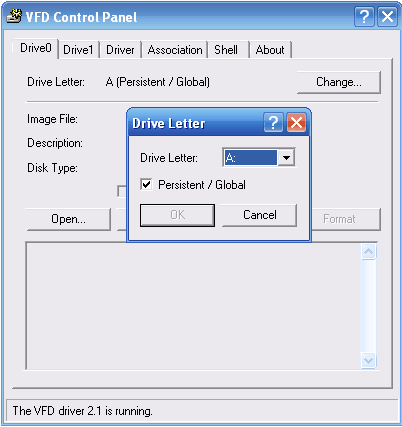- Virtual Floppy Drive Software Windows 7
- Virtual Floppy Drive Windows 10
- Virtual Floppy Drive Windows 7
- Virtual Floppy Disk
- Virtual Floppy Drive Software Free
I am trying to install a program which requires me to have a floppy disk in my machine while the installation is going on.
I found a program called Virtual Floppy Drive that allowed me to create the drive and copy files to it, but it only works on 32-bit systems.
Apr 24, 2013 Download Virtual Floppy Drive for free. This is a virtual floppy drive for Windows NT / 2000 / XP / 2003 / Vista / Windows 7 (both 32-bit and 64-bit versions). Virtual Floppy Drives Software Simplified Virtual Floppy Drive (VFD) v.2.1 A virtual floppy drive that mounts image files (.img) as new browseable computer resources. You can mount a floppy image file as a virtual floppy drive and directly access the contents view, edit, rename, delete or create files on a virtual floppy.
When I try to run it on Windows 7 64-bit, it gives me an error saying the virtual drive can't run on 64-bit systems.
I also tried using the subst a: c:myadrive in the command prompt, and it does not work.
Is there another way to accomplish this?
Der Hochstapler
migrated from stackoverflow.comSep 1 '10 at 5:38
This question came from our site for professional and enthusiast programmers.
8 Answers
The main download page for Virtual Floppy Drive is http://sourceforge.net/projects/vfd/. It supports Windows 7 64-bit.
But there are comments on the Sourceforge page saying it does not work in Windows 7 64bit. One user (toantu) found a way and posted a comment further down.
First copy the content of virtual floppy folder to C:temp.
Download dseo13b.exe, install ... right click and choose run with administrator, select enable test mode, reboot, run it again with administrator, select sign a system file, type in C:tempvfd.sys
Go to C:temp folder, right click vfd.exe, choose properties, go to compatibility tab, select run this program in compatibility mode for XP and also select run this as an administrator, select driver tab, select browse, select vfd.sys, press install and start. Go to drive0 tab, select change, choose A for your drive, OK. Now select open/create, click create and hopefully your drive will be activated in Windows 7 64-bit. You must run all of the above with administrator right by the way, and make sure you have 64-bit version of 2 files vfd.dll & vfd.sys
It seems to me that the question asks how to mount virtual images on 64-bit Windows systems, though not stated.
ImDisk accomplishes this result.
If your need is less complex, mounting A: to a folder would work fine.
GaffYou don't even need additional software for this. Create a folder called 'a', share it, map it as a network drive to A:. No need for additional downloads. I have used this on a lot of legacy systems that need floppy drives to transfer license keys.
You will need 2 files from here: http://levicki.net/articles/stories/2007/08/17/The_story_of_the_vfdwin_21_64-bit_driver_patch.php
Replace 'vfd.dll' & 'vfd.sys'
Self Sign the Driver with the tool mentioned in the given link
Reboot - Disable 'Proper' Driver Signature Enforcement if you want it to be permanent:
Start the Program- Install Driver
If you have Windows 7 Professional or Ultimate you can use virtual Windows XP Mode to run 32-bit programs that do not run on 64-bit systems.
Any virtual machine, VirtualBox for example, can be used as well with a 32-bit virtual Windows environment.
Peter MortensenVirtual Floppy Drive Software Windows 7
James MertzAs was previously stated, ImDisk does work with Windows 7 Ultimate 64-bit. I tried VFD, and it works great in 32-bit, but it does not work in 64-bit. I have even tried Critical0's fix and it doesn't work either, even though I am on an AMD machine. I am using a new six-core Black Edition CPU.
I tried ImDisk, and it works great if you follow the directions to the letter. Do not venture off his directions. Once you get the command prompt in administrator mode, you're good to go, and it will stay working from that point on.
Also, it runs it as a service, rather than via some icon on your desktop, I like that much better than VFD anyhow. This way, it's always there if I want it, and I can run more than two virtual floppies or even CDs/DVDs.
I used to use VFD all the time, so I know what I'm doing. I am a computer tech and an operating system creator, which is why I needed virtual floppies. From there, I can take the floppy image and use it on a CD or whatever I want from there to boot off.
You can turn your USB thumb drive into drive A: by first disabling the floppy drive in your BIOS. Then going into disk management console and changing your USB thumb drive's letter to A:, Now you should be able to get by any programs forcing you to use drive A:.
Virtual Floppy Drive Windows 10
You can use a virtual floppy drive (VFD), but you need to install it in a non-standard way.I've found a solution how to install it under Windows Vista x64, and I think the procedure for Windows 7 is similar.
Virtual Floppy Drive Windows 7
Please, checkout the solution at Virtual floppy drive for Vista?.
Good luck.
Peter Mortensen